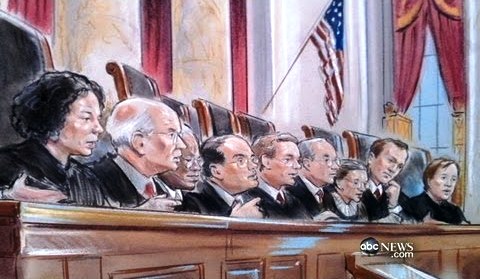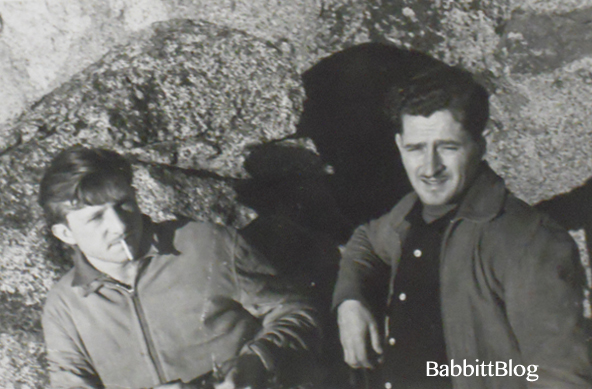In honor of the recent landmark healthcare decision made by the U.S. Supreme Court, I’m going to talk about one of my favorite past members of the Supreme Court.
Disney animator Les Clark.
I use “Supreme Court” loosely, but by President Franklin Roosevelt’s own standards. During the Great Depression, journalists Robert Allen and Drew Pearson coined the term “Nine Old Men” to deride the staunch members of the Supreme Court who refused to pass Roosevelt’s New Deal proposals.
 Today, Roosevelt is ranked beside Washington and Lincoln as one of the greatest presidents of the United States for steering the nation through an economic crisis and a world war — but during the Great Depression his laws were deemed unconstitutional and he was criticized by Capitol Hill. Roosevelt’s National Recovery Administration (a different NRA than you’re used to) attempted to allow federal government to step in and monitor prices and wages of of businesses. The Nine Old Men of the Supreme Court scrapped it, calling it unconstitutional. By the end of 1936, the Supreme Court had also overturned the National Industrial Recovery Act and the Agricultural Adjustment Act. Without these programs, there was no New Deal. There was no rebounding economy.
Today, Roosevelt is ranked beside Washington and Lincoln as one of the greatest presidents of the United States for steering the nation through an economic crisis and a world war — but during the Great Depression his laws were deemed unconstitutional and he was criticized by Capitol Hill. Roosevelt’s National Recovery Administration (a different NRA than you’re used to) attempted to allow federal government to step in and monitor prices and wages of of businesses. The Nine Old Men of the Supreme Court scrapped it, calling it unconstitutional. By the end of 1936, the Supreme Court had also overturned the National Industrial Recovery Act and the Agricultural Adjustment Act. Without these programs, there was no New Deal. There was no rebounding economy.
So Roosevelt had enough. He argued that these old fogies can’t see the forest for the trees. You need young minds to change things, and he went so far as to campaign for his famous court-packing bill which would add 6 new justices – one for every sitting justice older than 70.
You gotta be pretty fed up to try and restructure the Supreme Court!
In early 1937, Roosevelt was tossing the term “Nine Old Men” around so much, it had entered pop culture.
At the start of 1937, the players of the Supreme Court were:
Louis Brandeis (age 80) (liberal)
Benjamin Cardozo (age 66) (liberal)
Harlan F. Stone (age 64) (liberal – forming the “three musketeers“)
James Clark McReynolds (age 74) (conservative)
George Sutherland (age 74) (conservative)
Willis Van Devanter (age 77) (conservative)
Pierce Butler (age 70) (conservative – forming the “four horsemen“)
Chief Justice Charles Evans Hughs (age 74) (swing vote)
Owen J. Roberts (age 61) (swing vote)
Last week, our current Supreme Court passed President Obama’s health care proposal (which I refuse to call “Obamacare”) by a vote of 5-4. The deciding vote belonged to conservative justice John Roberts, who most admires Robert Jackson, Roosevelt’s Supreme Court justice pick in 1941. Perhaps Roberts’ behavior is a sign of changing times in our government and economy, as it was 70 years ago.
Walt Disney didn’t elect a chief justice. He had a bunch of talented men (only men were elevated at Disney’s) who did a lot of the art, but his most loyal were his animators (it’s argued that their status was a little more comfortable because Walt was more impressed by the skill). After the 1941 Disney Strike, Walt designated his own “Nine Old Men,” an offbeat honor given to nine young animators. And Les Clark was the member of The Nine who knew Walt the longest.
 When Art Babbitt arrived at Disney’s in 1932, he natually gravitated towards Les Clark. Les Clark was quiet and diligent, taking his work seriously but never demanding the spotlight. Babbitt must have been thrilled to meet the man who animated the xylophone scene in 1929’s Skeleton Dance – it was this short that convinced Babbitt to apply to Disney’s in the first place.
When Art Babbitt arrived at Disney’s in 1932, he natually gravitated towards Les Clark. Les Clark was quiet and diligent, taking his work seriously but never demanding the spotlight. Babbitt must have been thrilled to meet the man who animated the xylophone scene in 1929’s Skeleton Dance – it was this short that convinced Babbitt to apply to Disney’s in the first place.
They worked together to complete almost all the animation for the 1936 Academy-Award-winning short, The Country Cousin, with Clark getting the sober-mouse scenes in the first half and Babbitt getting the drunken-mouse scenes in the second.
Also by this time, the two had bonded as friends along with animator Bill Tytla. The three would go camping together and clay skeet shooting in Red Rock Canyon. Clark would attend parties at Babbitt’s and Tytla’s abode with his wife Mimi.
___
While Babbitt became a Goofy specialist, Clark became a Minnie Mouse specialist. Their mutual respect would foster throughout the rest of the 1930s and into the ’40s. It would be shattered in 1941, when Babbitt would lead the Disney Strike, and Clark would remain loyal to the company until his dying day. Les Clark achieved legendary status and financial security for himself and his family

Les Clark, John Lounsbery (two of the Nine Old Men), and Art Babbitt, circa mid-1940. Courtesy of Andreas Deja
It begs to wonder: what would have happened had Babbitt stayed in? Can there be more than merely Nine Old Men? If FDR can propose it, why can’t we?









This is a great and articulate post. Your analysis of Roosevelt’s “Nine Old Men” is not something you’d find in most reports of Disney using the term for his animators. It’s not something I’d expect on an animation blog, but it really informs the use of the term by Disney. What was a negative for Roosevelt was a positive for Disney – or was it?
Pingback: Extra! Les Clark Sends Greetings | babbittblog
Pingback: The Third Disney Task | babbittblog